The bathroom is a room that has special requirements. This is due to the fact that the room is operated in specific conditions and has a separate microclimate. In order to ensure the protection of materials from moisture or to exclude troubles that may arise due to pipe leaks, it is necessary to carry out waterproofing. These works are also carried out in the case when tiles are supposed to be used as a finishing.
The need for waterproofing the floor
Intermittent steam generation, high humidity, condensation and temperature changes all negatively affect the finish, floors and furnishings in the bathroom. Through the seams, moisture penetrates under the tiles and accumulates under the tiles. For the emergence and reproduction of fungus, mold and harmful bacteria, favorable conditions are created in the seams and joints.
You can independently carry out waterproofing of the bathroom under the tiles. What is better to use, you can understand if you read the information below. The layer created in the course of the described work will act as a guarantee of the safety of the floor, ceiling and walls, which is especially true for emergency situations.
What to choose for waterproofing in the bathroom
The materials presented for sale for waterproofing in the bathroom are quite diverse today. Oleechnaya their variety, for example, is impregnated with traditional bitumen. However, the industry offers more modern solutions. The most popular varieties are the following compositions:
- coating;
- lining;
- liquid;
- pasty;
- penetrating;
- waterproof;
- dry.
Description of some varieties
The latter are used to prepare solutions. Mixtures include waterproofing plaster and sprayed materials. The waterproofing coating for the bathroom under the tiles is offered in the form of a mastic. Whereas the gluing materials can have a waterproofing impregnation. If you like pasty liquid mixtures, then among them you can single out polymer-cement solutions like Ceresit waterproofing.
Concrete solution
If you have to work with concrete, it is better to prefer penetrating waterproofing, which can change the structure of porous materials. When, in addition to waterproofing work, it is also necessary to level the surface, it is better to choose a waterproofing plaster. Sprayable compositions are made on a polymer or rubber base; after solidification, they form a film hydro-barrier.
If you will be waterproofing the bathroom under the tiles, which is better to choose, you must decide even before you visit the store. The main criterion in this case is the technical characteristics of the room. You need to take into account that the bathroom does not provide for the need to use such an effective waterproofing as the foundation.

Cost is also important. If you want to carry out the work yourself, then you need to pay attention to the technology, it should not be too complicated. In addition, the mixtures can be one- or two-component. The former must be combined with water, while the latter are made using a polymer emulsion.
When to use coated waterproofing
In the family of compounds for waterproofing, if we are talking about its coating variety, you can include:
- painting materials;
- bituminous mastics.
With the help of paint waterproofing, a thin coating can be formed on the protected surface. Such materials include bitumen mastic, as well as water-repellent varnishes and paints, with which you can protect metal and wood structures. Application is carried out in two layers, as a tool you can use a brush or roller. This is true for wall decoration.
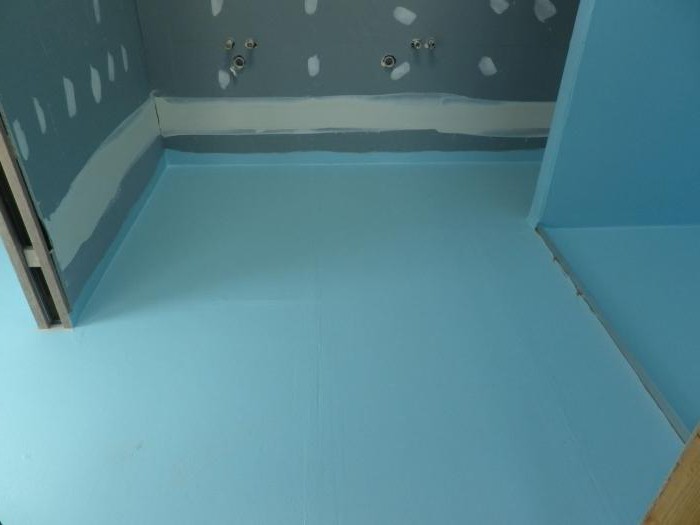
If you have to protect the floor, then it is poured with a mixture, which then has to be distributed with a scraper. If you will be waterproofing a bathroom under tiles, which is the best choice, you must decide at the planning stage. As the best option for concrete, cement and cement-sand surfaces, bitumen mastics, as well as mixtures based on oxidized bitumen, are used. Modifying ingredients are added to the composition, they increase strength, eliminate toxicity and make the mixture elastic. Application is carried out on a horizontal surface in one or more layers; a spatula must be used for this.
Screed solution
If you want to fill the floor with a screed at the next stage, then it is better to apply a coating waterproofing. With its help, you can create a continuous seamless film or interlayer, this is the advantage of this material. If you will be waterproofing a bathroom under a tile, which is better to purchase, you must decide even before you visit the store. You can replace the traditional type of screed with a coating paste, which is made on a cement basis. In this case, no high requirements are imposed on the preparation of the rough surface. Only a priming is required, which is required to strengthen weak top layers and to optimize adhesion.
For reference
Dry surfaces can be treated with a bitumen-based waterproofing paste. This applies to formulations that are enriched with silicone, rubber and acrylic. To evaporate moisture, you need to stop using the bathroom for 3 days until the water-repellent protection is provided.
Quite often, mastic is used as an adhesive, on the surface of which, at the next stage, a sheet or roll version of the material is covered. In this case, the thickness of the layer will determine the quality of the preparation of the rough surface. It is important to exclude height differences, but deviations are still permissible, they can reach 4 mm for every 2 m 2. After applying the mastic, the differences should not exceed 2 mm in the same area.
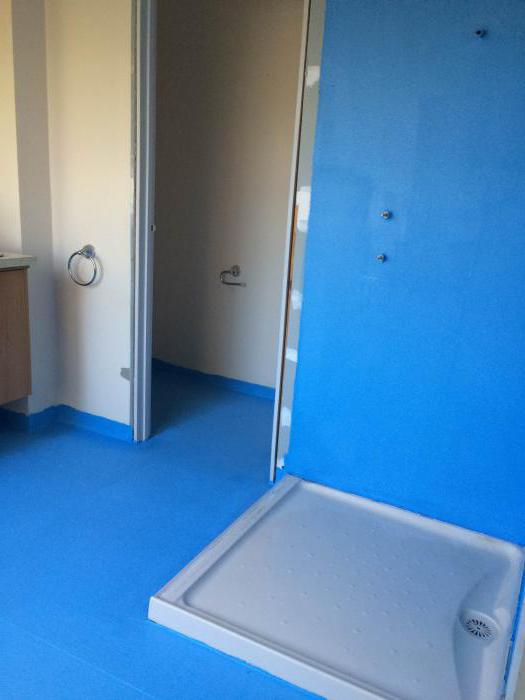
Waterproofing "Hydroflex"
You must have seen green tile waterproofing in your bathroom. In this case, we are talking about a ready-made dispersion mixture, which is intended for internal work. It is made in Italy and is a pasty material based on latex and water. The products are environmentally friendly, safe to use and easy to apply.
The material produced under the aforementioned brand assumes a whole system, which includes:
- primer;
- adhesive waterproofing mixture;
- grout for joints.
If you need waterproofing of the bathroom floor under the tiles, then you can choose "Hydroflex", which is also offered for sale in the form of waterproofing plasters and tapes. Which elements of the system to choose will depend on the operating conditions of the room. If the room is not heated, there is a possibility that the temperature will drop below 0 ° C. In this case, it is recommended to prefer elastic materials made on a cement or reactive base.
When carrying out internal work, it is better to use waterproofing, which will also provide elasticity and reliability. After purchasing the composition, you can immediately use it, it is ready for use. Application should be done with a paint roller, a smooth metal trowel or a wide paint brush. The mixture is applied in 2 layers. If there are bases in the room that absorb moisture, they must first be covered with a primer, after which you can start waterproofing.
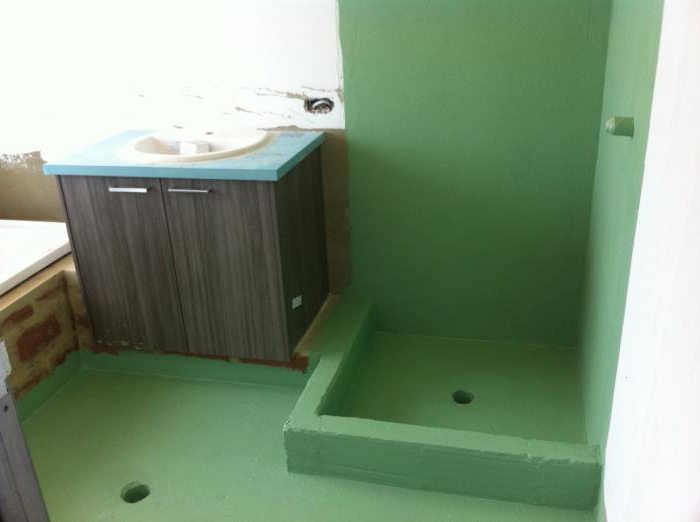
In places of abutments and joints, a waterproofing tape is laid. As soon as the first layer of the mixture is dry, the tape can be covered with a second layer of waterproofing. It is recommended to use finished products made of waterproofing tape to protect the inner and outer corners. To protect the outlets of drain holes and pipes, plasters are used, laid according to the same technology as waterproofing tape.
The described waterproofing of the bathroom floor under the tiles is applied with a second layer only after the first has dried, which will happen after 2 hours. This is true for a 2mm layer. The direction of movement should be perpendicular to the first layer. After the second layer has dried, which will happen in a day, you can start laying the tiled cladding. The waterproofing mixture "Hydroflex", after hardening, forms a surface that does not absorb moisture. Therefore, for the work on laying tiles, it is necessary to use highly elastic and elastic reactive or cement compositions.
Waterproofing in a wooden house
Waterproofing a bathroom under a tile in a wooden house is required. For this, you can use gluing materials. However, it should be borne in mind that they are quite difficult to use. If you nevertheless decide to resort to this technology, then you should prefer a bitumen self-adhesive polymer membrane. Those consumers for whom quality is paramount should purchase materials of foreign production.
If the house has not yet been built, then at the project stage it is necessary to focus on coating waterproofing. This is also due to the fact that it is characterized by high and stable rates of recovery and elongation, which is important for timber buildings. Lubricating waterproofing for a bathroom under a tile in a wooden house also has a right to exist. Among such solutions, one can single out polymer-bitumen compositions that fit under the screed. You can also prefer polymer-cement compositions that are applied over the screed. Capillary mastic based on rubber and bitumen have excellent performance, its protective layer has the ability to preserve even with deformation of wooden structures.
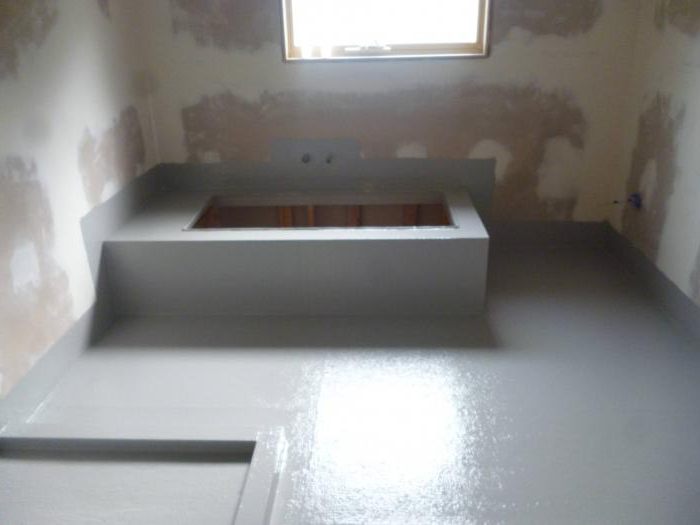
Polymer-cement mastics are flexible two-component coatings. One ingredient is a powdery mixture that contains binding moisture-protective compounds and correctly selected inert fillers. Another ingredient in this mixture is an aqueous dispersion of acrylic-based polymers. After mixing the components, it is possible to obtain a high-tech mixture that has excellent adhesion.
If you will be waterproofing the bathroom floor, then the system can be given additional strength with the help of polymer-cement waterproofing, which is represented by a fiberglass reinforcing mesh. It is placed between the first and second layers using a sealing elastic tape. You can also install the tape at the joints between horizontal and vertical surfaces.
Waterproofing "Knauf-Flähendicht"
Waterproofing the bathroom floor under the Knauf tiles is presented for sale in the Flechendicht variety. In this case, we are talking about an aqueous dispersion of inert fillers made of synthetic latex. The mixture is blue and contains no solvents among the ingredients. The composition can be used in conjunction with bases that are sensitive to moisture. These include:
- gypsum fiber sheets;
- gypsum plaster;
- plaster screed;
- gypsum plasterboard sheets;
- slabs and blocks containing gypsum.
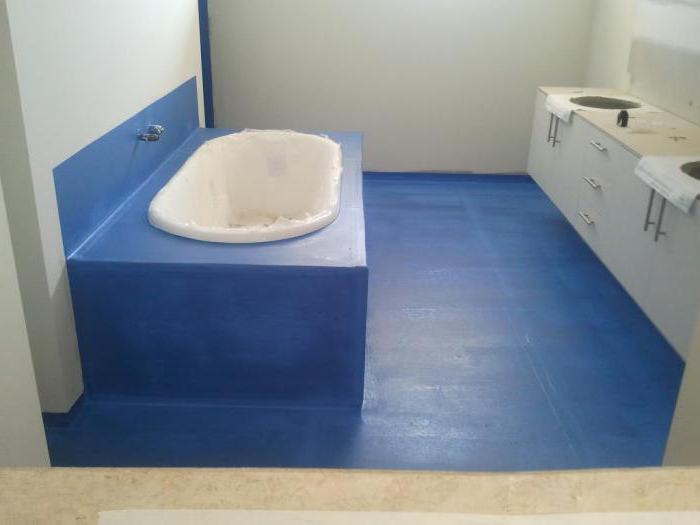
Such waterproofing of bathroom walls under tiles can be applied to mineral substrates, namely:
- lime-cement;
- calcareous;
- cement plasters;
- cement screeds;
- cement slabs;
- porous concrete.
With the help of the mixture, you can form a waterproof elastic surface, which is excellent for the further laying of ceramic tiles and natural stone. The mixture works well with cement-based tile adhesives. Such waterproofing of a bathroom under a tile with your own hands can be carried out for interior work.
Conclusion
If you will be waterproofing the bathroom floor under the tiles, what material to use, experts in this field will tell you. These can be pasting compounds, which are bitumen. It is laid with an overlap with a width of 5 to 10 cm. The material should go on the surface of the walls. The roll is fused or glued with bitumen mastic. Press down the material with a roller. The joints and connections of communications are additionally sealed.



